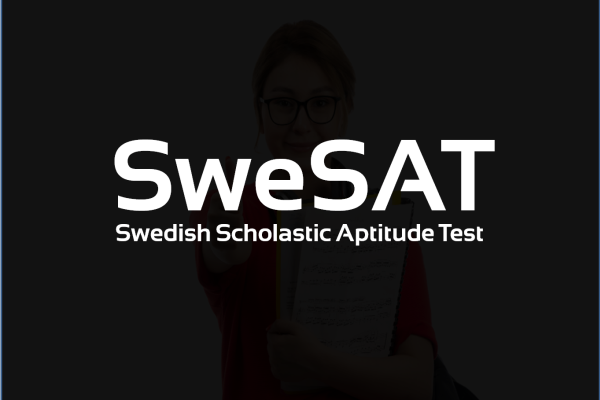Exam Date: August 17, 2025
The Swedish Scholastic Aptitude Test, commonly known as SweSAT (in Swedish: Högskoleprovet), is a standardized test used for admission to higher education institutions in Sweden.
Overview of SweSAT (Högskoleprovet)
• Purpose: A standardized test used for admission to higher education in Sweden.
• Administered by: Swedish Council for Higher Education (Universitets- och högskolerådet, UHR).
• Frequency: Twice a year – in April (Spring) and October (Autumn).
• Duration: Approximately 7.5 to 8 hours, including breaks.
• Languages: All sections are in Swedish, except for the English reading comprehension section.
• Registration: Done online via hogskoleprov.nu.
• Cost: Varies annually; for example, 550 SEK in Spring 2021.
Exam Pattern :
Quantitative Part (80 questions)
XYZ – Mathematical Problem Solving: 24 questions assessing arithmetic, algebra, geometry, statistics, and function theory.
KVA – Quantitative Comparisons: 20 questions evaluating the ability to make quantitative comparisons.
DTK – Diagrams, Tables, and Maps: 24 questions measuring the ability to interpret visual data.
NOG – Data Sufficiency: 12 questions determining whether enough information is provided to solve a problem.
Verbal Part (80 questions)
ORD – Vocabulary: 20 questions testing awareness of word meanings.
LÄS – Swedish Reading Comprehension: 20 questions assessing understanding of Swedish texts.
MEK – Sentence Completion: 20 questions examining the ability to complete sentences meaningfully.
ELF – English Reading Comprehension: 20 questions evaluating understanding of English texts.
An additional fifth subtest is included to develop new questions for future tests; however, its results are not counted towards the final score.
Eligibility Criteria
National Students
General Eligibility: Open to all individuals with a Swedish personal identity number.
Age Requirement: Typically, candidates are at least 18 years old.
International Students
General Eligibility: Open to all individuals who meet the registration requirements.
Language Proficiency: While the test is in Swedish (except for the English section), international students should have a sufficient understanding of the language.
University Admission: SweSAT scores can be used for admission to Swedish universities, but some programs may require additional qualifications. swedeneducation.info+2en.wikipedia.org+2studyinsweden.eu+2
Syllabus Breakdown:
Quantitative Sections
XYZ: Focus on problem-solving in mathematics, including topics like arithmetic, algebra, geometry, statistics, and function theory.
KVA: Assess the ability to make quantitative comparisons in various mathematical contexts.
DTK: Interpretation of data presented in diagrams, tables, and maps.
NOG: Determine whether sufficient information is provided to solve mathematical problems.en.wikipedia.org+1swedeneducation.info+1
Verbal Sections
ORD: Understanding the meaning of words and concepts.
LÄS: Comprehension of Swedish texts, requiring the ability to perceive details and draw conclusions.
MEK: Ability to complete sentences meaningfully, testing language proficiency.
ELF: Understanding of English texts, assessing the capacity to perceive information and follow arguments.en.wikipedia.org
Evaluation & Scoring
Scoring Scale: Results are normalized to a scale between 0.0 and 2.0, with increments of 0.05.
Top Score: Approximately 145–150 correct answers are required for a score of 2.0.
Average Score: Typically around 0.87, with a standard deviation of about 0.40.
Score Distribution: Approximately two-thirds of test-takers score between 0.50 and 1.30, and 95% score between 0.20 and 1.70. en.wikipedia.org
Experts of just my iq suggest:
• Familiarize with Test Format: Understand the structure and types of questions in each section.
• Practice Regularly: Engage in timed practice sessions to improve speed and accuracy.
• Focus on Weak Areas: Identify and work on areas where you are less confident.
• Use Official Resources: Utilize past papers and official practice materials.
• Develop Time Management Skills: Learn to allocate time effectively during the test.
• Stay Updated: Keep track of any changes in test format or registration procedures.
Official Test Dates: Held in April (Spring) and October (Autumn) each year.
Registration Portal: hogskoleprov.nu
Official Information: uhr.se/en
Practice Materials: provtips.com
The SweSAT is a standardized test used for admission to higher education in Sweden. It serves as an alternative or supplement to grade-based selection when there are more qualified applicants than available study places. The test is divided into two main sections: verbal and quantitative, each containing multiple-choice questions. The test is administered twice a year: once in the spring (Saturday) and once in the autumn (Sunday).
Age Requirement: Candidates must be 18 years old in the calendar year the test is administered or have started upper secondary school earlier than the calendar year in which they turn 16.
Language Proficiency: The test is conducted in Swedish, so proficiency in the Swedish language is essential for success.
Citizenship: There are no restrictions regarding citizenship or residency
Spring Test: Typically held on a Saturday at the end of March or the beginning of April.
Autumn Test: Held on a Sunday in October.
Registration Period: Opens about two weeks before the application deadline.
Application Fee: 550 SEK
